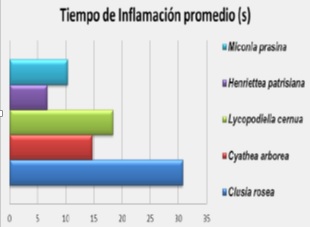Influence of moisture variables, layer and shape of fuel flammability of some plant species associated with pine ecosystems
Main Article Content
Abstract
Article Details
As part of the submission process, authors are required to check off their submission meets all the elements listed below, and they know that shipments that do not meet these guidelines may be returned to the author.
DECLARATION OF ORIGINALITY
The author Authorship and author who refers or shipping to UPR CIFAM, CERTIFY:
- That each of the people in it are listed as author or author has contributed directly to the intellectual content of the work, approves the contents of the manuscript is submitted to editorial process and gives its consent that their name appears on the authorship thereof.
- That the request has not been previously published, it is not under review in another journal, nor included in another paper accepted for publication by another publisher.
- That in the event that the content has been presented in a communication or congress, the current request is a substantial modification thereof and has properly been cited text on which it is based. This circumstance an explanation is provided to the publisher at the right place of the submission form (box "Comments to the Editor").
- That each of the people listed as author or author agrees not to submit this work for consideration by another publication while in CIFAM Journal editorial process.
- It has been recognized in a note the article, by way of thanks, the contribution of those which are not signatories to the same or responsible for the final version, have contributed substantially to the development of labor so and have given their permission to such mention.
- Data and publications in which the information contained in the work, or who have had a significant influence on it is based have been cited in the text and in the list of references, being responsible, in respect of rights author refers, of any dispute or claim relating to intellectual property rights, exonerating from liability CIFAM journal.
Likewise, the author who submitted work must confirm compliance with the following points:
- The text meets the style and bibliographic requirements outlined in the "Uniform requirements for manuscripts submitted to the journal."
- If the text is attached to a section of the journal subject to peer review (see policy sections), has made sure to follow the directions given in Ensuring Blind Review.
- The file is sent in DOC or DOCX format.
- Where it has been possible, they have been added and DOI web addresses in the references.
Copyright Notice:
Authors who publish in this journal agree to the following terms:
- The authors retain copyright, ensuring Journal CIFAM the right of first publication of the work that refer to the magazine to be submitted to the editorial process.
- Authors know that his work is published under a Creative Commons License Attribution-NonCommercial 4.0 International that allows others to share it with a recognition of the authorship of the work and its initial publication in this journal.
- The authors give to the CIFAM Journal the rights of exploitation of the work which has been published in this journal, authorizing the publishing of it for the exercise of a free reproduction, distribution and public communication without commercial purposes.
- Authors know that their work will be stored on servers and reproduced in digital format for inclusion in institutional repositories and databases that will facilitate free access to the full text of the work.
- Authors can distribute the version of the work published in CIFAM Journal (for example, to an institutional repository or publish it in a book), with an express acknowledgment of its initial publication in this journal.
References
AGEE, J.K., SKINNER, C.N. Basic principles of forest fuel reduction treatments. Forest Ecol. Manage, 2005, 211, 83-96.
- ARNALDOS VIGER, J. et. al. Manual de ingeniería básica para la prevención y extinción de incendios forestales. Madrid: Mundi Prensa, 2004.
- BATISTA, A.C. Y SOARES, R.V. Manual de prevenção e combate a incêndios florestais. Curitiba. Paraná. Brasil, 1997.
- BEVERLY JL. AND WOTTON BM. Modelling the probability of sustained flaming: predictive value of fire weather index components compared with observations of site weather and fuel moisture conditions. International Journal of Wildland Fire, 2007, (16), 161–173. doi: 10.1071/WF06072.
- BLACKMARR, WH. Moisture content influences ignitability of slash pine litter. USDA Forest Service, Southeastern Forest Experiment Station, Research Note SE-173. (Macon, GA). 1992.
- BOWMAN, D.M.et. al. Fire in the Earth System. Science, 2009, (324), 481 -
- BRUCE, J. G. Systematics and Morphology of Subgenus Lepidotus of the
Genus Lycopodium (Lycopodiaceae). 1975.
- CHANDLER, C. et. al. Fire in forestry. Vol. I. Forest fire behavior and effects. Florida: Krieger Publishing Company, 1991.
- CHANDLER, C. et. al. Fire in Forestry. Vol. I. John Wiley. Nueva York, Estados Unidos, 1983.
- CONABIO. Catálogo taxonómico de especies de México. Cap. nat. México.
- CURT T. et. al. Vegetation flammability and ignition potential at road-forest
interfaces (southern France). In ‘Proceedings of the 4th International Wildland Fire Conference’. May 2007, Sevilla, Spain. (CD-ROM) Madrid, Spain: Ministerio de Medio Ambiente, 2007.
- DELABRAZE, P. Y VALETTE, J.CH. Etude de inflamabilité et de la combustibilité. Consultation technique FAO sur les incendies de forests en pays méditerranéns. 1997.
- DIMITRAKOPOULOS, A.P. A statistical classification of Mediterranean species base dons their flammability components. International Journal of Wildland Fire, 2001, (10), 113-118.
- DIMITRAKOPOULOS, A.P. Y MATEEVA, V. 1998. Effect of moisture content on the ignitability of Mediterranean species. En Proceedings of the III International Conference on Forest Fire Research, ADAI. Coimbra, 1998, 1, p. 455-456.
- ELLIS, P.F. The aerodynamic and combustion characteristics of eucalypt bark: a firebrand study. PhD thesis. Canberra: Australian National University, 2000.
- ELVIRA, L.M. Y HERNANDO, C. Inflamabilidad y energía de las especies de sotobosque. Madrid: Instituto Nacional de Investigaciones Agrarias, 1989.
- FERREIRA, A.D. Igniçao de combustiveis finos por fósforos. In ‘Jornadas Científicas sobre Incendios Florestais’, November 1988, Coimbra, Portugal. Ed. DX Viegas. Portugal: University of Coimbra, 1998, p. 281-289.
- FORZZA, R. C. et al. Lista de espécies Flora do Brasil. 2010.
- FRANDSEN, W.H. (1987) the influence of moisture and mineral soil on the combustion limits of smouldering forest duff. Canadian Journal of Forest Research, 1987, (17), 1540–1544. doi: 10.1139/X87-236.
- FRANDSEN, W.H. Ignition probability of organic soils. Canadian Journal of
Forest Research, 1997, (27), 1471–1477. doi: 10.1139/CJFR-27-9-1471.
- GUIJARRO, M. Comportamiento del fuego y régimen térmico en diferentes
complejos de combustible forestal. Ministerio de Ciencia y Tecnología. Tesis doctoral inédita. INIA. Madrid, 2003.
- GUIJARRO, M. et. al. Inflamabilidad de la hojarasca de diferentes especies
forestales: influencia de la humedad y de la densidad aparente del combustible. Madrid: Instituto Nacional de Investigaciones Agrarias, 2002.
- HARRINGTON, S. Measuring Forest Fuels. An Overview of Methodologies,
Implications for Fuels Management. Forest Guild Research Center. Working
Paper 19, 2005.
- HARTFORD, R.A. Smouldering combustion limits in peat as influenced by
moisture, mineral content and organic bulk density. In ‘Proceedings of the
th Conference on Fire and Forest Meteorology’, Ottawa, Canada. Eds DC
MacIver, H Auld, R Whitewood. Ottawa, ON: Forestry Canada &
Environment Canada, 1989, pp. 282–286.
- HATTON, T.J. et. al. The influence of soil moisture on Eucalyptus leaf litter moisture. Forest Sci. 1998, 34(2), 292-301.
- HERNÁNDEZ, A. et. al. Nueva versión de clasificación genética de los suelos de Cuba. Instituto de suelos. Ciudad de la Habana: MINAGRI, 1999. ISBN: 959-246-022-1.
- HERNANDO, C. Combustibles forestales: inflamabilidad. En la Defensa Contra Incendios Forestales: Fundamentos y Experiencias. Capítulo 6. Madrid: McGraw Hill, 2000.
- HERNANDO, C. Combustibles forestales: Inflamabilidad. En: La defensa contra incendios forestales: fundamentos y experiencias. 2a ed. Madrid, España: McGraw-Hill/Interamericana de España, S. A. U. 2009, p. 123 – 130.
- ICONA. Manual de Operaciones contra Incendios Forestales. España: Ministerio de Agricultura, Pesca y Alimentación. Instituto Nacional para la Conservación de la Naturaleza, 1993.
- JAIME, M.F. Inflamabilidad de especies vegetales del ecosistema de pinares. Tesis de Diploma inédita, Universidad Hermanos Saiz Monte de Oca, Pinar del Río, 2013.


